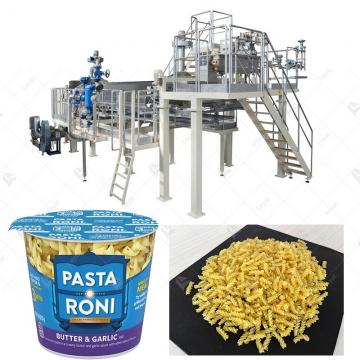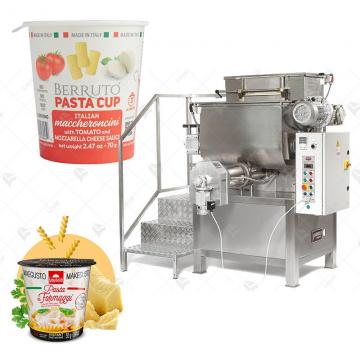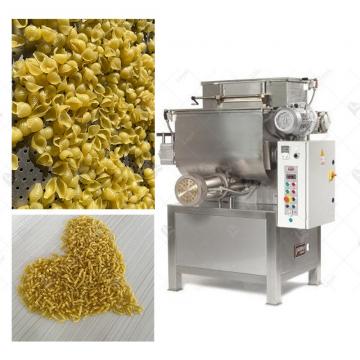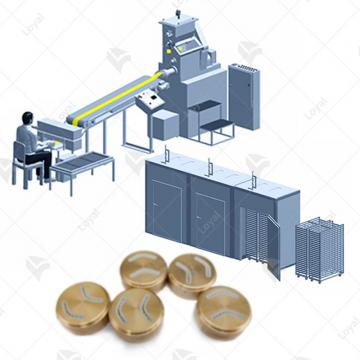
- Shandong Loyal Industrial Co.,Ltd.
- SHORT-CUT PASTA PRODUCTION LINE LONG-CUT PASTA PRODUCTION LINE INSTANT PASTA PRODUCTION LINE
Home> Company News> The Ultimate Guide To Dry Pasta Production Line In 2024

The Ultimate Guide To Dry Pasta Production Line In 2024
2024-03-28 11:43:36Dry pasta, a staple in many households worldwide, is made from durum wheat semolina mixed with water. The dough is extruded through molds to create various shapes and sizes of pasta, which are then dried to remove moisture. This process ensures a longer shelf life and makes pasta convenient for storage and transportation.
Importance of Efficient Production Lines
Efficient dry pasta production lines are essential for meeting the ever-growing demand for pasta products. These lines streamline the manufacturing process, from mixing and extrusion to drying and packaging, ensuring consistent quality and minimizing waste. With the right equipment and technology, producers can optimize output while maintaining cost-effectiveness.

Importance of Efficient Production Lines
Efficient production lines are the backbone of any manufacturing operation, and this holds especially true for dry pasta production. The significance of having an efficient production line cannot be overstated, as it directly impacts various aspects of the business, including productivity, cost-effectiveness, and customer satisfaction.
1. Maximizing Productivity: An efficient production line ensures that the maximum output is achieved within the shortest possible time frame. By optimizing workflow and minimizing downtime, producers can significantly increase their overall productivity. This allows them to meet customer demand promptly and capitalize on market opportunities.
2. Reducing Costs: Inefficient production lines often lead to unnecessary waste, higher energy consumption, and increased labor costs. By streamlining operations and eliminating inefficiencies, producers can reduce their overall production costs. This not only improves profitability but also allows them to offer competitive prices to consumers.
3. Maintaining Product Quality: Consistency is key when it comes to dry pasta production. An efficient production line ensures that each batch of pasta meets the required quality standards, from texture and flavor to appearance and shelf life. This is essential for building consumer trust and loyalty in the brand.
4. Adapting to Market Demands: The food industry is constantly evolving, with changing consumer preferences and market trends. An efficient production line is flexible and adaptable, allowing producers to quickly adjust their production schedules and product offerings in response to market demands. This agility is essential for staying competitive in the dynamic food market.
5. Ensuring Food Safety and Compliance: Food safety is paramount in dry pasta production, where products are consumed by millions of people worldwide. An efficient production line is equipped with robust quality control measures and adheres to strict regulatory standards, ensuring that the final products are safe for consumption.
Types of Dry Pasta Production Produced
In the realm of pasta manufacturing, the utilization of advanced dry pasta production line technology has revolutionized the industry. These modern pasta manufacturing equipment have enabled the efficient and cost-effective production of various types of pasta. Let's explore some of the most common types of dry pasta production and the industrial pasta making equipment utilized in their creation.
1. Spaghetti: Spaghetti is a long, thin cylindrical pasta that is a staple in Italian cuisine. Its production typically involves extrusion through a die on a dry pasta production line. The extruded dough is then cut to the desired length using industrial pasta making equipment.
2. Penne: Penne is a tube-shaped pasta with ridges on the surface. Its production requires specialized dies on a dry pasta production line to create the characteristic shape. Industrial pasta making equipment then cuts the extruded dough into uniform lengths.
3. Fusilli: Fusilli is a spiral-shaped pasta that is popular in both Italian and international dishes. The production of fusilli involves extruding the dough through a special die on a dry pasta production line. As the dough is extruded, it is twisted into spirals using industrial pasta making equipment.
4. Farfalle: Farfalle, also known as bowtie or butterfly pasta, is characterized by its distinctive bowtie shape. To produce farfalle, the dough is extruded and then cut into small rectangles using specialized dies on a dry pasta production line. Industrial pasta making equipment then folds the rectangles to create the final bowtie shape.
5. Rigatoni: Rigatoni is a large, tube-shaped pasta with ridges on the surface. Its production involves extruding the dough through specially designed dies on a dry pasta production line. Industrial pasta making equipment then cuts the extruded tubes to the desired length, resulting in uniform rigatoni pieces.
6. Rotini: Rotini is a corkscrew-shaped pasta that is commonly used in pasta salads and casseroles. Its production requires the use of a dry pasta production line equipped with a specialized die that shapes the dough into spirals. Industrial pasta making equipment then cuts the spirals to the appropriate length.
7. Macaroni: Macaroni is a small, curved pasta shape that is often used in macaroni and cheese dishes. Its production involves extruding the dough through a die on a dry pasta production line to create the characteristic shape. Industrial pasta making equipment then cuts the extruded dough into short, curved pieces.
8. Linguine: Linguine is a long, flat pasta similar to spaghetti but wider. Its production involves extruding the dough through a die on a dry pasta production line to achieve the desired thickness. Industrial pasta making equipment then cuts the extruded dough into long, flat strands.
9. Orzo: Orzo is a small, rice-shaped pasta that is commonly used in soups and salads. Its production requires the use of a dry pasta production line equipped with a specialized die that shapes the dough into tiny pellets. Industrial pasta making equipment then dries and packages the orzo for distribution.
10. Elbow: Elbow pasta, also known as macaroni elbows, is a small, curved pasta shape commonly used in macaroni and cheese dishes. Its production involves extruding the dough through a die on a dry pasta production line to create the characteristic elbow shape. Industrial pasta making equipment then cuts the extruded dough into short, curved pieces.
Raw Materials Used in Dry Pasta Production
Durum wheat semolina: Durum wheat semolina is the primary ingredient in dry pasta production. It is a coarse flour made from durum wheat, which is high in protein and gluten, giving pasta its characteristic texture and elasticity.
Water: Water is essential for hydrating the durum wheat semolina and forming the dough. The ratio of water to semolina is crucial for achieving the desired consistency and texture of the pasta.
Salt: Salt is added to the dough to enhance the flavor of the pasta. It also helps strengthen the gluten structure, improving the texture and cooking properties of the pasta.
Eggs (optional): Some pasta recipes may include eggs as an additional ingredient. Eggs add richness and color to the pasta dough, resulting in a slightly different texture and flavor compared to eggless pasta.
Other additives (optional): Depending on the desired characteristics of the pasta, other additives such as vegetable purees or spices may be incorporated into the dough. These additives can impart unique flavors, colors, and nutritional benefits to the final product.
Key Stages of Dry Pasta Production Manufacturing Process
The dry pasta production line is a complex and intricate system that involves several key stages to produce high-quality pasta products. Let's delve into the pasta manufacturing equipment and the industrial pasta making process.
1. Raw Material Preparation:
Before the pasta production process begins, raw materials such as durum wheat semolina are carefully selected and stored in silos. The semolina is then mixed with water to form a dough with precise moisture content and consistency.
2. Mixing and Kneading:
In this stage, the semolina-water mixture undergoes thorough mixing and kneading in large industrial mixers. This process ensures proper hydration of the semolina particles and the development of gluten, which gives pasta its desired texture and elasticity.
3. Extrusion:
The dough is then fed into the extruder, a machine equipped with specialized dies that shape the pasta into various forms such as spaghetti, penne, or fusilli. The extrusion process applies pressure to the dough, forcing it through the die openings to create the desired pasta shapes.
4. Cutting and Shaping:
Once extruded, the pasta is cut to the desired length and shape by precision cutting machines. These machines can produce a wide range of pasta shapes with consistent accuracy.
5. Drying:
Drying is a crucial stage in the pasta production process, where the freshly formed pasta is dried to reduce its moisture content and increase shelf stability. The pasta is transferred to drying chambers, where hot air circulates around it, gradually drying it to the desired moisture level.
6. Packaging:
After drying, the pasta is cooled and inspected for quality control purposes. Once approved, it is packaged using automated packaging equipment. The packaging process ensures that the pasta remains fresh and free from contamination until it reaches the consumer.
7. Quality Control:
Throughout the entire pasta production process, strict quality control measures are in place to monitor the quality and consistency of the final product. This includes regular testing of raw materials, monitoring of production parameters, and sampling of finished products for sensory evaluation.
8. Storage and Distribution:
The packaged pasta is then stored in warehouses under controlled conditions to maintain its quality before distribution to retailers or consumers. Efficient distribution channels ensure that the pasta reaches its destination in a timely manner, ready to be enjoyed by pasta lovers worldwide.
Dry Pasta Production Line: Ensuring Quality Control Measures
In the realm of food production, the dry pasta production line stands as a testament to precision engineering and stringent quality control measures. From the raw ingredients to the final packaged product, every step of the process is meticulously monitored to uphold the highest standards of quality and consistency.
Raw Materials Selection:The foundation of any pasta product lies in the selection of premium quality raw materials. At the onset of the production line, dry pasta production line operators meticulously source the finest durum wheat semolina, ensuring optimal protein content and gluten strength. This ensures that the resulting pasta boasts superior texture and resilience during cooking, meeting consumer expectations for taste and mouthfeel.
Mixing and Extrusion:As the semolina is introduced into the mixing chamber, it undergoes a precise blending process to achieve the desired consistency and hydration level. Through careful calibration of water content and mixing duration, the dough emerges with the ideal elasticity for extrusion. The extrusion stage, a hallmark of the dry pasta production line, sees the dough transformed into myriad shapes and sizes, from spaghetti to penne, each crafted with artisanal precision.
Drying and Quality Control:Upon exiting the extruder, the freshly formed pasta undergoes a controlled drying process essential for shelf stability and texture preservation. Within the drying chambers, temperatures and humidity levels are closely monitored to facilitate gradual moisture removal without compromising structural integrity. This critical phase exemplifies the commitment to dry pasta production line quality control, ensuring uniform drying across all pasta varieties.
Packaging and Inspection:Before reaching the final consumer, every batch of pasta undergoes rigorous inspection to detect any imperfections or irregularities. Automated systems equipped with advanced sensors scrutinize each individual piece, identifying deviations in shape, color, or size. Any anomalies trigger immediate rejection, safeguarding the integrity of the product. Additionally, packaging materials are carefully selected to preserve freshness and prevent contamination, further underscoring the commitment to quality.
Continuous Improvement:In the dynamic landscape of food production, the quest for perfection is never-ending. Manufacturers of dry pasta production lines remain steadfast in their pursuit of innovation and continuous improvement. By leveraging cutting-edge technology and embracing best practices, they strive to raise the bar for quality and customer satisfaction.
Factors to Consider Before Setting Up a Dry Pasta Production Line
Setting up a dry pasta production line requires careful consideration of various factors to ensure efficiency and success. Here are some key points to keep in mind:
1. Quality of Pasta Manufacturing Equipment: Investing in high-quality pasta manufacturing equipment is crucial for producing consistent and high-quality pasta products. Look for machinery that is durable, reliable, and capable of handling the specific requirements of your production line.
2. Production Capacity: Determine the desired production capacity of your industrial pasta making operation. Consider factors such as market demand, distribution channels, and scalability when deciding on the size and scale of your production line.
3. Cost and Budget: Conduct a thorough cost analysis to determine the initial investment required for setting up the production line. Factor in expenses such as equipment purchases, facility rental or construction, utilities, labor, and raw materials.
4. Location: Choose a suitable location for your production facility that offers easy access to transportation, raw materials, and distribution networks. Consider factors such as proximity to suppliers and customers, availability of skilled labor, and regulatory requirements.
5. Raw Materials Sourcing: Ensure a steady and reliable supply of high-quality raw materials such as durum wheat flour for pasta production. Establish relationships with reputable suppliers and consider factors such as pricing, quality, and consistency.
6. Quality Control Measures: Implement stringent quality control measures throughout the production process to ensure the consistency and safety of your pasta products. This includes monitoring raw materials, production processes, and finished products for compliance with quality standards.
7. Regulatory Compliance: Familiarize yourself with the regulatory requirements and food safety standards governing pasta production in your region. Ensure compliance with regulations related to food safety, labeling, packaging, and sanitation to avoid legal issues and protect consumer health.
8. Market Research: Conduct market research to identify trends, preferences, and competition in the pasta industry. Understand your target market and tailor your product offerings to meet consumer demand and differentiate yourself from competitors.
9. Automation and Technology: Embrace automation and technology to streamline production processes, improve efficiency, and reduce labor costs. Invest in equipment and software solutions that enhance productivity, accuracy, and flexibility in pasta manufacturing.
10. Sustainability Practices: Consider implementing sustainable practices in your production process to reduce environmental impact and appeal to eco-conscious consumers. Explore options such as energy-efficient equipment, waste reduction strategies, and eco-friendly packaging materials.
Routine Maintenance of Dry Pasta Production Line
1. Dry Pasta Production Line: The heart of any pasta manufacturing facility, the dry pasta production line consists of various components such as mixers, extruders, dryers, and packaging machines. Each component plays a vital role in the pata-making process.
2. Routine Maintenance: To maintain peak performance, it's essential to conduct routine maintenance on all components of the dry pasta production line. This includes daily, weekly, monthly, and yearly checks and tasks.
3. Daily Maintenance: Daily tasks may include inspecting equipment for any signs of wear or damage, cleaning and sanitizing surfaces, lubricating moving parts, and checking for proper alignment.
4. Weekly Maintenance: Weekly maintenance tasks may involve more in-depth inspections, such as checking belts and chains for tension and wear, inspecting electrical connections, and cleaning filters and screens.
5. Monthly Maintenance: Monthly maintenance tasks may include calibrating equipment, checking for leaks or air loss, inspecting bearings and motors, and replacing any worn or damaged parts.
6. Yearly Maintenance: Yearly maintenance tasks are more extensive and may require shutting down the production line for thorough inspection and servicing. This can include replacing belts, chains, and other wear parts, inspecting and cleaning ventilation systems, and conducting performance tests.
7. Importance of Maintenance: Regular maintenance not only prevents unexpected breakdowns but also ensures product quality, reduces energy consumption, and extends the lifespan of equipment. It also helps identify potential issues before they escalate into costly repairs.
8. Maintenance Schedule: Developing a comprehensive maintenance schedule is essential for staying on top of routine tasks and ensuring they are completed in a timely manner. This schedule should be followed diligently by trained personnel.
9. Training and Documentation: Proper training of maintenance staff is crucial for executing tasks safely and effectively. Additionally, keeping detailed records of maintenance activities, including dates, tasks performed, and any issues identified, helps track the dry pasta production line's maintenance history and informs future maintenance needs.
In conclusion, routine maintenance is essential for the efficient operation of a dry pasta production line. By following a comprehensive maintenance schedule, conducting regular inspections, and addressing issues promptly, you can minimize downtime, optimize performance, and maximize the lifespan of your equipment.
Environmental Impact of Dry Pasta Production Line Manufacturing
The production of dry pasta involves several stages, including milling, mixing, extrusion, drying, and packaging. Each stage of the process can have environmental implications, from energy consumption to waste generation. However, advancements in technology have enabled manufacturers to reduce their environmental footprint. By investing in energy-efficient machinery and optimizing production processes, dry pasta production line manufacturers can minimize their energy consumption and greenhouse gas emissions.
Additionally, the choice of raw materials can significantly impact the environmental sustainability of dry pasta production. By using locally sourced ingredients and implementing sustainable farming practices, manufacturers can reduce the carbon footprint associated with ingredient sourcing. Furthermore, initiatives to reduce water usage and minimize waste can further enhance the environmental sustainability of dry pasta production.
Sustainable Practices in Sourcing Ingredients
Sourcing sustainable ingredients is crucial for reducing the environmental impact of dry pasta production. Manufacturers can achieve this by partnering with suppliers who prioritize sustainable farming practices, such as organic farming and crop rotation. By sourcing ingredients locally, manufacturers can also support local economies and reduce the carbon emissions associated with transportation.
Furthermore, some manufacturers are exploring alternative ingredients, such as whole grains and legumes, to enhance the nutritional value of their products while reducing the environmental impact. By diversifying their ingredient sourcing and incorporating sustainable practices, manufacturers can create a more resilient and environmentally friendly supply chain.
Recycling and Waste Management Initiatives
In addition to sustainable sourcing practices, recycling and waste management initiatives play a crucial role in reducing the environmental impact of dry pasta production. Manufacturers can implement strategies to reduce packaging waste, such as using recycled materials and minimizing excess packaging. Additionally, by investing in composting and recycling infrastructure, manufacturers can divert organic waste from landfills and create valuable resources for agriculture.
Furthermore, manufacturers can explore innovative solutions for reusing and repurposing waste generated during the production process. By-products such as bran and germ can be used as animal feed or incorporated into other food products, reducing waste and creating additional revenue streams.
In conclusion, sustainability is an increasingly important consideration for dry pasta production line manufacturers. By focusing on environmental impact reduction, sustainable ingredient sourcing, and recycling and waste management initiatives, manufacturers can minimize their carbon footprint and contribute to a more sustainable food system.
Dry Pasta Current Market Trends
The demand for dry pasta production lines continues to soar, driven by several factors. Firstly, consumers are increasingly turning to convenience foods, and dry pasta fits the bill perfectly. Its long shelf life and versatility make it a staple in households worldwide. Secondly, the rise of health-conscious consumers has spurred demand for whole grain and gluten-free pasta variants, prompting manufacturers to innovate in this space. Thirdly, globalization has facilitated the spread of pasta consumption beyond traditional pasta-eating regions, creating new markets and opportunities for growth.
Dry Pasta Emerging Technologies
Advancements in technology are revolutionizing the dry pasta production line industry. One notable innovation is the adoption of automation and robotics in manufacturing processes. Automated systems streamline production, reduce labor costs, and enhance efficiency. Additionally, advances in extrusion technology have enabled the production of pasta with superior texture and nutritional profile. Furthermore, sustainable practices such as energy-efficient production methods and waste reduction initiatives are gaining traction, driven by consumer demand for eco-friendly products.
Predictions for the Future
Looking ahead, the future of dry pasta production lines appears promising. Market analysts project continued growth fueled by rising global pasta consumption. Furthermore, ongoing research and development efforts are expected to yield breakthroughs in product innovation and process optimization. With the advent of smart manufacturing technologies and data analytics, manufacturers can anticipate greater precision in quality control and supply chain management. Additionally, the emphasis on sustainability is likely to intensify, driving investments in renewable energy sources and eco-friendly packaging solutions.
References
1. International Pasta Organization (IPO)
(https://www.internationalpasta.org/)
2. European Pasta Association (UNAFPA)
3. American Italian Pasta Company (AIPC)
4. Pasta & Couscous Manufacturers Association (PCMA)
5. Pasta Production Technology - ResearchGate
(https://www.researchgate.net/topic/Pasta-Production-Technology)
 Instant Pasta Production Line
Instant Pasta Production Line INSTANT PASTA CUP PRODUCTION LINE
INSTANT PASTA CUP PRODUCTION LINE PRECOOKED PASTA PRODUCTION LINE
PRECOOKED PASTA PRODUCTION LINE Dry Pasta Production Line
Dry Pasta Production Line